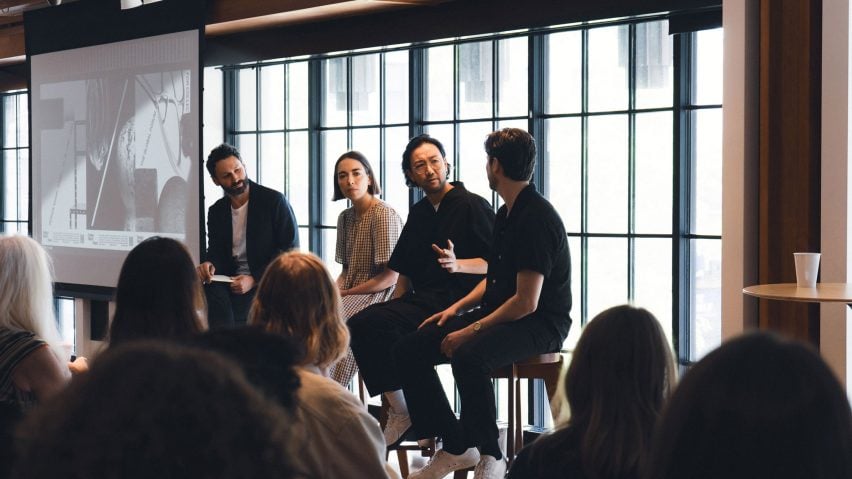Promotion: interdisciplinary collaboration is crucial to the future of design studios, members of design collective The New Standard said in a talk hosted by Dezeen during NYCxDesign 2024.
Taking place at the Ace Hotel in Brooklyn and hosted by Dezeen's co-CEO Benedict Hobson, the talk featured Universal Design Studio creative director Satoshi Isono, Map Project Office creative director Emilie Robinson and Made Thought creative director Matt Delbridge.
Together, the three design studios make up The New Standard, a collective founded in 2021. According to the panellists, the idea behind working together as a collective was to maximise the opportunity to collaborate while maintaining each studio's specialism.
"If we're doing our jobs right, we're not thinking about design in a silo," said Delbridge. "We're thinking about design as an overarching idea, and how can we build the right thing for the world."
"It's not a new idea," he added. "It's actually a really old idea. It's the Charles and Ray Eames approach to Design with a capital D."
"I think somewhere along the way, we started to get siloed and that was easier to sell on a commercial level. I think we're just resurfacing something that's been around for a long time."
Each of the studios that make up The New Standard has a different area of expertise. Universal Design Studio (Universal) is an architecture and interior studio, while Map Project Office (Map) is an industrial design studio and Made Thought focuses on branding and strategy.
When digital agency AKQA gained a controlling stake in all three studios in 2021, they chose to form a collective rather than merge into a larger, all-purpose agency.
"We are individual studios with our individual specialisms, but we're also The New Standard, it's about all coming together as three," said Robinson.
Until now, all three companies have been based in the same office in London, which was designed by Universal Design Studio in 2019.
"We have our studios all on the same floor. We all work together and influence each other's work. And that's really what it's about – creating something that feels really coherent and consistent," Robinson said.
Delbridge noted that the collaboration between the three studios is strongest when "activating" a space, which pulls in "touch points" from each studio.
"The place where the collaboration really happens is when we start thinking about movement and how to activate the space," he said. "Being able to cross-collaborate makes you feel a brand and not just see it."
The studios’ work with IBM Research, for example, showcases the strength of the partnership.
With a relationship spanning almost a decade, Universal and Map have worked on a variety of projects for the brand, including the design of IBM Quantum System One and IBM Quantum System Two - quantum or super computers that are each encased within their own airtight space.
They are also working on the transformation of the IBM’s Yorktown Heights campus, originally completed in 1961 by Eero Saarinen, which houses the computers.
Together, the three studios have also worked on the inaugural publication, the New Standard, which highlights the collective’s work, as well as collaborators, clients and others it looks to for inspiration, including space environmentalist Moriba Jah and VP of Design at IBM Research Susana Rodriguez de Tembleque.
The talk marked the opening of the collective's first US office in Soho, New York City, which is headed up by Isono. He said that over time he plans to build up the US office to foster the same spirit of collaboration as the London office.
"It's just the beginning for us [in the US]", he said. "The studio space needs to evolve so we can collaborate with local designers and collaborate with clients in the space as well."
The creative directors explained that projects come in individually to each studio, but presenting as a team to clients and working in the same office allows the process to be more flexible, ultimately resulting in projects that do not adhere to one medium.
"When the client comes to us and they just see us as an overarching group of people that are working together for the same goal, that's when I think it has a success to it," said Robinson.
The panellists discussed the complication of "selling the service" and keeping a creative business financially viable as the industry shifts over time, with each expert expressing different strategies.
"The onus is on us to show what the true value of creativity is," said Delbridge. "I think it's on us at the moment to make people understand that the value isn't how much money you're going to make today but fundamentally rethinking your business and strategically thinking about the true value of the creative partnership."
"For us, keeping the studio not very large is an important thing," added Isono. "So that we know what we're working on and working together. That helps keep us creative, but it's also potentially effective as well."
They also stressed the importance of establishing a trusting relationship with a client, noting that early conversations have the largest impact on the success of a project.
It's also where environmentally conscious and sustainable approaches are integrated, they said.
"If we can build trust, then we can be in those conversations early on," said Robinson. "We can try and find ways to answer those problems rather than being too far down the line and trying to be more reactive than proactive."
The photography is courtesy of Universal Design Studio and Map Project Office.
Partnership content
This article was written by Dezeen for The New Standard as part of a partnership. Find out more about Dezeen partnership content here.

